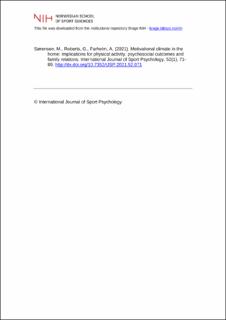| dc.contributor.author | Sørensen, Marit | |
| dc.contributor.author | Roberts, Glyn | |
| dc.contributor.author | Farholm, Anders | |
| dc.date.accessioned | 2021-11-25T10:50:45Z | |
| dc.date.available | 2021-11-25T10:50:45Z | |
| dc.date.created | 2021-10-11T12:55:24Z | |
| dc.date.issued | 2021 | |
| dc.identifier.citation | International Journal of Sport Psychology. 2021, 52(1), 71-89. | en_US |
| dc.identifier.issn | 0047-0767 | |
| dc.identifier.uri | https://hdl.handle.net/11250/2831458 | |
| dc.description.abstract | The impact of motivational climate created by coaches/teachers on children is well documented. There is little knowledge about the motivational climate in the home. This study investigated the perceived motivational climate in the home and achievement goals, physical activity involvement, and psychosocial outcomes such as empathy, family relationships, school grades, general mastery and psychological problems for 15-16 year old adolescents. Methods: Data were collected by questionnaires in a cross-sectional design. Participants were 1940 boys and 1871 girls. Gender differences necessitated separate analyses, but for both genders, mastery climate was indirectly, positively related to physical activity, mastery, empathy, family relations, and school grades via task orientation. The home climate had a direct relationship with the achievement orientation of the children and the orientation of the child had gender specific relationships to physical activity, family relationships and general mastery. Conclusion: A home mastery climate is associated with more adaptive outcomes. | en_US |
| dc.language.iso | eng | en_US |
| dc.subject | home motivational climate | en_US |
| dc.subject | physical activity | en_US |
| dc.subject | psychosocial outcomes | en_US |
| dc.subject | youths | en_US |
| dc.title | Motivational climate in the home: Implications for physical activity, psychosocial outcomes and family relations | en_US |
| dc.type | Peer reviewed | en_US |
| dc.type | Journal article | en_US |
| dc.description.version | publishedVersion | en_US |
| dc.rights.holder | © International Journal of Sport Psychology | |
| dc.subject.nsi | VDP::Idrettspedagogikk og -psykologi: 333 | en_US |
| dc.subject.nsi | VDP::Physical education and sport psychology: 333 | en_US |
| dc.source.pagenumber | 71-89 | en_US |
| dc.source.volume | 52 | en_US |
| dc.source.journal | International Journal of Sport Psychology | en_US |
| dc.source.issue | 1 | en_US |
| dc.identifier.doi | 10.7352/IJSP.2021.52.071 | |
| dc.identifier.cristin | 1944889 | |
| dc.description.localcode | Institutt for idrett og samfunnsvitenskap / Department of Sport and Social Sciences | en_US |
| cristin.ispublished | true | |
| cristin.fulltext | original | |
| cristin.qualitycode | 1 | |
